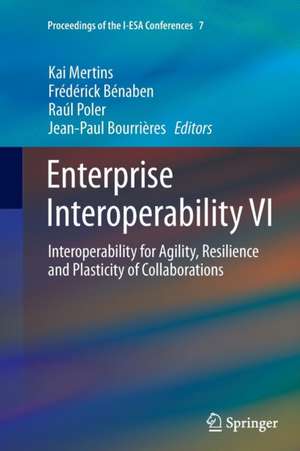Enterprise Interoperability VI: Interoperability for Agility, Resilience and Plasticity of Collaborations: Proceedings of the I-ESA Conferences, cartea 7
Editat de Kai Mertins, Frédérick Bénaben, Raúl Poler, Jean-Paul Bourrièresen Limba Engleză Paperback – 3 sep 2016
| Toate formatele și edițiile | Preț | Express |
|---|---|---|
| Paperback (1) | 1228.47 lei 6-8 săpt. | |
| Springer International Publishing – 3 sep 2016 | 1228.47 lei 6-8 săpt. | |
| Hardback (1) | 1234.62 lei 6-8 săpt. | |
| Springer International Publishing – 5 mar 2014 | 1234.62 lei 6-8 săpt. |
Preț: 1228.47 lei
Preț vechi: 1498.13 lei
-18% Nou
Puncte Express: 1843
Preț estimativ în valută:
235.08€ • 242.88$ • 195.55£
235.08€ • 242.88$ • 195.55£
Carte tipărită la comandă
Livrare economică 19 martie-02 aprilie
Preluare comenzi: 021 569.72.76
Specificații
ISBN-13: 9783319358369
ISBN-10: 3319358367
Pagini: 539
Ilustrații: XV, 524 p. 158 illus., 114 illus. in color.
Dimensiuni: 155 x 235 x 28 mm
Greutate: 0.75 kg
Ediția:Softcover reprint of the original 1st ed. 2014
Editura: Springer International Publishing
Colecția Springer
Seria Proceedings of the I-ESA Conferences
Locul publicării:Cham, Switzerland
ISBN-10: 3319358367
Pagini: 539
Ilustrații: XV, 524 p. 158 illus., 114 illus. in color.
Dimensiuni: 155 x 235 x 28 mm
Greutate: 0.75 kg
Ediția:Softcover reprint of the original 1st ed. 2014
Editura: Springer International Publishing
Colecția Springer
Seria Proceedings of the I-ESA Conferences
Locul publicării:Cham, Switzerland
Cuprins
Introduction.- Business Interoperability.- Enterprise Modelling for Enterprise Interoperability.- Semantics for Enterprise Interoperability.- Architectures and Frameworks for Interoperability.- Future Internet and Enterprise Systems.- Platforms for Enterprise Interoperability.- Services for Enterprise Interoperability.- Enterprise Interoperability Science Based.- Standards for Interoperability.- Interoperability Scenarios and Case Studies.
Textul de pe ultima copertă
A concise reference to the state of the art in systems interoperability, Enterprise Interoperability VI will be of great value to engineers and computer scientists working in manufacturing and other process industries and to software engineers and electronic and manufacturing engineers working in the academic environment.
Over 40 papers, ranging from academic research through case studies to industrial and administrative experience of interoperability show how, in a scenario of globalised markets, where the capacity to cooperate with other firms efficiently starts to become essential in order to remain in the market in an economically, socially and environmentally cost-effective manner, the most innovative enterprises are beginning to redesign their business model to become interoperable. This goal of interoperability is essential, not only from the perspective of the individual enterprise but also in the new business structures that are now emerging, such as supply chains, virtual enterprises, interconnected organisations or extended enterprises, as well as in mergers and acquisitions. Establishing efficient and relevant collaborative situations requires to manage interoperability on a dynamic point of view: a relevant and efficient collaboration of organizations might require adaptation to remain in line with potentially changing objectives, potentially evolving resources, unexpected events, etc. Many of the papers contained in this, the seventh volume of Proceedings of the I-ESA Conferences have examples and illustrations calculated to deepen understanding and generate new ideas.
The I-ESA’14 Conference from which this book is drawn was organized by Ecole Nationale Superieure des Mines d’Albi-Carmaux, on behalf the European Virtual Laboratory for Enterprise Interoperability (INTEROP-VLab) and sponsored by the International Federation for Information Processing (IFIP).
Over 40 papers, ranging from academic research through case studies to industrial and administrative experience of interoperability show how, in a scenario of globalised markets, where the capacity to cooperate with other firms efficiently starts to become essential in order to remain in the market in an economically, socially and environmentally cost-effective manner, the most innovative enterprises are beginning to redesign their business model to become interoperable. This goal of interoperability is essential, not only from the perspective of the individual enterprise but also in the new business structures that are now emerging, such as supply chains, virtual enterprises, interconnected organisations or extended enterprises, as well as in mergers and acquisitions. Establishing efficient and relevant collaborative situations requires to manage interoperability on a dynamic point of view: a relevant and efficient collaboration of organizations might require adaptation to remain in line with potentially changing objectives, potentially evolving resources, unexpected events, etc. Many of the papers contained in this, the seventh volume of Proceedings of the I-ESA Conferences have examples and illustrations calculated to deepen understanding and generate new ideas.
The I-ESA’14 Conference from which this book is drawn was organized by Ecole Nationale Superieure des Mines d’Albi-Carmaux, on behalf the European Virtual Laboratory for Enterprise Interoperability (INTEROP-VLab) and sponsored by the International Federation for Information Processing (IFIP).
Caracteristici
Keeps the reader up to date with developments in a field which is extremely important for industrial competitiveness International author pool means that readers can learn about the environment in many countries with which they may have to co-operate Inter-disciplinary subject matter allows the reader to learn about many points of view on similar problems Includes supplementary material: sn.pub/extras




































